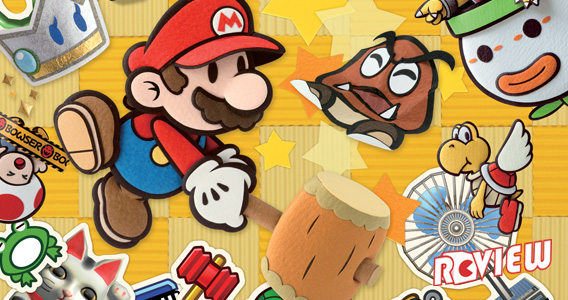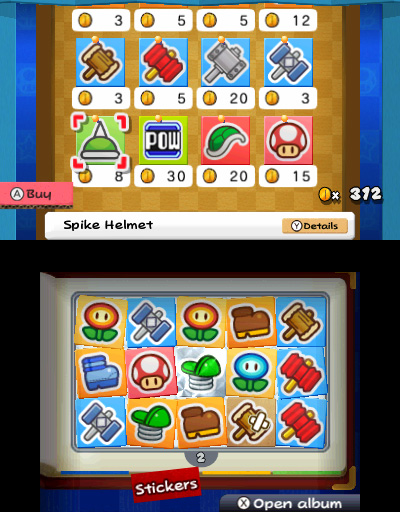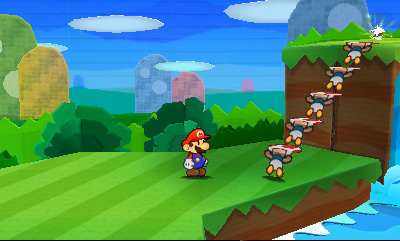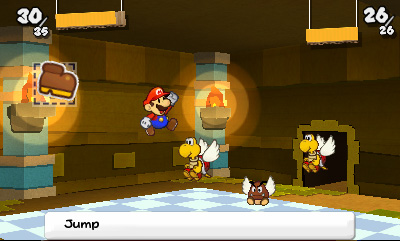
Though it will likely come as no surprise to hear that Bowser has once again crashed the festivities of the Mushroom Kingdom, it’s not entirely his fault. Given that the Kingdom has a party for just about everything, the Koopa King would be hard pressed to show up when there wasn’t an event being held.
This time Bowser crashes the party during the annual Sticker Festival, where his attempt to seize power causes royal stickers to scatter across the Kingdom, setting Mario up nicely to do his hero thing – said thing being to visit deserts and snowy peaks in order to retrieve the stars and bring Bowser’s latest dictatorship to an end.
Naturally, the 2D paper aesthetic runs deep in this 3D landscape, from cardboard health bars to enemies that crumple when stomped – an ideal environment for Nintendo’s attempt to augment the series with layers of stickers that litter the landscape to provide players with the means to once again defeat Bowser’s minions.

This paper Kingdom deserves plenty more words than I’ll give it here – all that really needs to be said is that everything is made out of paper, save for whatever happens to be a sticker. But this doesn’t really get the idea across, the mix of visual and tactile joy that comes from wandering around forests where Mario can knock over bushes to reveal their cardboard backside, or watch new set pieces unfurl to suddenly have a tower unfold and rise into the sky. The visual strength and charm of the game never falters.
That Mario now travels this landscape peeling stickers off of the environment adds a new level to the tactile wonder – the power-ups of the series are stuck across every stage of the journey, requiring Mario to peel them off of trees and buildings in order to add them to his sticker album for use in battle.
In RPG fashion, touching enemies within stages triggers a turn-based battle screen, wherein players can select a sticker from their album in order to issue offensive or defensive moves – boots and hammers for stomping and knocking out enemies, spiked hats to protect against enemy jump attacks, and even a frog suit that allows Mario to leap over incoming attacks.

Mario begins each battle with one move per turn, but coins can be spent to try a slot game, where matching up to three items will reward Mario with up to three attacks before enemies take their turn. That might leave you thinking that Mario could run short on stickers, but you’ll often be pressed for space in the album and continually sorting out the better attacks like fire flowers and POW boxes from the twenty or so hammers that always seem to be on hand.
Each single enemy Mario engages in battle will often summon friends, which means Mario will often be facing two to four enemies per battle – thankfully some attack items can strike more than a single opponent.
Additionally, the A-button becomes the player’s best friend, as pressing it at the right moment will strengthen an attack – there’s risk and reward in waiting for the perfect moment to swing a hammer, potentially causing more damage by pressing the button at just the right moment, or just as easily waiting too long and having the mallet fall off the stick. Jump attacks can also be prolonged by pressing the A-button after each stomp to keep Mario bouncing until opponents crumple from the assault.

The mechanics at work here are divine, connecting the visual and tactile elements and providing space for additional input from the player to create something that captures the eyes and fingers, for a time. There’s even a variation of power based on the condition of the sticker, with slightly torn ones proving weaker and super shiny stickers adding extra moxy to attacks. The nagging problem is that players will likely be exhausted with these mechanics before reaching the halfway point of the game. In fact, I’m convinced that anyone play-testing this game had to have shouted “Oh come on dude!” repeatedly during such sessions.
This battle system can seem viciously hard, given that Mario doesn’t have a great deal of health to spare and can only slightly lower damage by blocking incoming attacks – once again pressing the A-button at the precise moment. It doesn’t take long to learn that there is always the right sticker for each encounter, though enemy variations make planning a challenge, and the most valuable stickers never seem to last long during a stage. Individual battles make the game appropriately challenging, but the frequency threatens to make them utterly frustrating.

The game features some of the most finely crafted levels Mario has traversed in quite some time, with secret items and exits crammed into each. This creates some wonderful time sinks as players attempt to guide Mario through the multiple passageways and discover hidden items, but also creates a space littered with enemies quite eager to engage players in battle. There are so many enemies crammed into every stage that the game quickly exhausts the wonder element of its battle system, and I wasn’t long for attempting to run past every enemy while trying to solve the puzzles of each stage.
The exhaustion increases because there is no real reward for battle beyond the initial delight of participating in the oddity of sticker attacks against paper characters. Victory doesn’t yield stat increases for Mario, rather his low amount of health is raised by discovering heart containers ala The Legend of Zelda. More powerful attacks aren’t something earned by prevailing in countless battles, but simply a matter of discovering and using more powerful stickers in the right situations.

Add to this a limited amount of space to carry stickers into battle, and the incentive disintegrates as quickly as a burning paper Goomba. Special items that Mario finds, such as fans, soda cans, and scissors, can be turned into stickers for use against enemies – ideally saved for boss encounters. These work like grand summon spells, again bringing visual magic to the screen as a giant electric fan rises in the background to blow away enemies.
However, given the amount of space these larger stickers occupy on Mario’s precious few album pages, players will often need to backtrack in order to have these on hand at the right moment. If you find a special item, like scissors, they can be turned into a sticker in the village where Mario starts his adventure. Should you need another version of said special sticker, it needs to be found again within the stage where it was originally discovered, or purchased in the town.
Naturally, if you happen to be halfway across the stage map at a fortress, you’ll need to make the trip back to town to spend the coins and ensure that you have the room in your album. As you might imagine, this makes for a great deal of backtracking around the world map.

The special sticker situation is incredibly punishing beyond boss concerns to boot. Within stages, Mario will consistently encounter roadblocks that require him to “paperize” the situation. This will remove Mario from the screen, which flattens out to show where a special sticker might be applied to solve a problem – perhaps a blowing tornado needs to be conquered by a key object.
Flipping through the available items that have been turned into stickers, you might want to try plugging a few of these potential solutions into the problem. Unlike just about any adventure game I can recall however, attempting to stick the wrong special sticker into the problem will cause you to lose that sticker – essentially killing any idea of trial and error and leaving you to smack your head against a wall as you spend precious coins attempting to find the right sticker for the job from a wide variety of special items.
Beyond heart containers, the Zelda-like influence here encourages quests of a sort as well, which could go a long way to creating something rewarding if you weren’t constantly dodging enemy encounters that seriously derail the searching.

In one instance, Mario needed three scraps of paper that would open a stage, with the three pieces hidden in three previous stages – clues in one stage lead me to the hiding place of one, solving a problem with a special sticker lead me to the piece of another. Overcoming enemy encounters made the entire experience one hundred times longer and frustrating than it needed to be however, with the game attempting to merge two styles of play that unfortunately fail to work together successfully. Both styles are fun on their own, but splitting attention between both is, again, continually distracting and utterly exhausting.
Sticker Star is also strangely absent of Nintendo’s usual intuitive design that naturally leads players toward a solution. At times, something really small and insignificant can prolong a puzzle just as easily as dying during the tenth battle in a row on the way toward one final door. Toward this end, Sticker Star provides the least helpful of companions with Kersti, a sticker fairy who can be summoned to offer such helpful advice as “Did you try paperizing to see where a sticker can go yet?”
The answer is, yes Kersti, I did, now how about you give me even a cryptic hint about which sticker might work here.

It’s aggravating that I can’t appreciate this title more – it fluctuates between wanting to be one of the better available 3DS titles, and wanting to leave me curled into a ragged sobbing mess on the floor. There’s every sense that Nintendo is trying to step out of a comfort zone here, juggling play themes to create something fresher for the trouble.
It’s worth noting that enemies haven’t come across with so much personality since Bowser’s Inside Story – watching a swarm of Goomba’s shout and defend a tower is only one instance of many where the game oozes a special charm often absent from main-line Mario games. Sticker Star has plenty of personality, but also a strange personality conflict that emerges and splinters as questing and battles collide for attention and I wander endless circles across the world map begging my heartless companion for a clue.
But there is plenty of good to speak of Sticker Star all the same, from the continually clever use of sticker and paper tricks in the narrative and battles, to the simple way the game allows players to poke around different areas of the world map without a strictly set order – and many stages that flat out require discovering all their secrets in order to progress. Sticker Star is also one of the first 3DS games in some time that gave me a reason to turn the 3D effect on in order to appreciate the paper characters flapping around the Kingdom.
There’s just no way to ignore that players will likely spend at least half of the adventure wandering around in the dark and endlessly retreading tired ground, until the many charms at the heart of the game wear just as thin as its paper characters.
Nintendo, Intelligent Systems
Publisher
Nintendo
System
Nintendo 3DS
Modes
Singleplayer
Release Date
November 11, 2012
*A copy of this title was provided by the publisher for review

I’m picking up my preorder later in the week. It will be interesting to see how the new sticker dynamic works for or against the game.
Comment by EdEN — November 11, 2012 @ 9:58 pm
lemme know what you think after trying it some. This definitely feels like a game that’ll have people on both sides of the fence.
Comment by Jamie Love — November 11, 2012 @ 10:20 pm
A well written article. It perfectly describes many of the feelings I have towards the game. I am without doubt that it is a high quality game. The visuals are great, the gameplay is seamless, and it’s well put together. However, the game is a repetitive, challenging grind. Sadly, Paper Mario: Sticker Star, like most of the current Nintendo 3DS titles has low quality gameplay.
Comment by Josiah Blouin — November 20, 2012 @ 3:29 pm